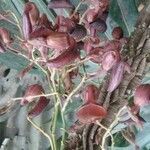Twining, scandent lianas. Leaves alternate, spiral, oblong-spatulate, apex acute to obtuse, sometimes minutely mu-cronate, base truncate to shallowly sub-cordate, 4 to 8 cm. broad, 10 to 20 cm. long, glabrous. Pseudostipules absent. Flowers in clustered racemes with reduced leaves, purple-brown, the utricle ovoid, ca. 3 cm. long, narrowing abruptly into the recurved tube, ca. 1 cm. long, which gradually widens into the strongly reflexed limb, ca. 3 cm. long. Fruit ovate-cylindric, ca. 15 cm. long, 7 cm. wide, dehiscing acropetally. Seeds numerous, horizontally compressed, 1.2 cm. diameter, 3 mm. thick.
A woody vine. It can grow 20 m long. The leaves large and rounded and are wedge shaped at the base. The flowers are brownish-purple. They can be 25 cm long. The fruit are seed capsules 12 cm long.

